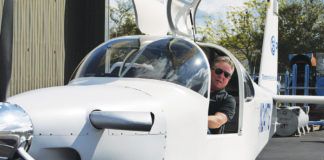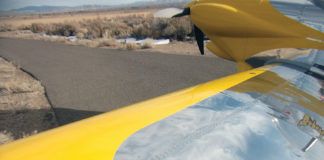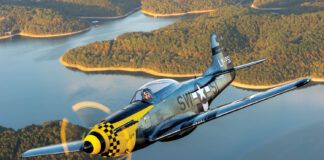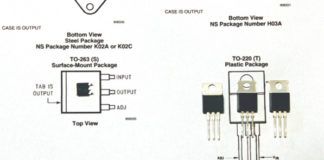Only one manufacturer of certified wood propellers remains in the U.S., and I came away from a tour of the factory with confidence that neither art, nor the will to embrace new technology is endangered at its central Florida facility.
Sensenich, pronounced sense-a-nick, got its start 75 years ago when two brothers in Pennsylvania placed a WW-I surplus aircraft engine in a wagon and went for a merry ride in what may be the first example of an air car. But it was a worn-out rope borrowed from their fathers hayloft that started the Sensenich brothers in the propeller business. After their “wind wagon” was ruled off the roads, they transferred their engine and propeller to an ice sled that traveled at high speeds in a 200-foot circle while tied to a center post. The rope broke, the sled cracked up, and the propeller was destroyed. Lacking funds to buy a new one, Harry and Martin Sensenich borrowed their fathers spokeshave and drawing knife and made one.
WW-II expanded the business as it supplied props for training aircraft as well as moving into the field of aluminum props. Recognizing the rising popularity of airboats, the Plant City, Florida, factory was spun off in 1994.
With the era of aircraft being sold with wood props virtually ending, Sensenich recognized a niche in composite props. An old technology (wood) and the newest technology (composites) existed side by side. Given that wood consists of fiber and liquids, it is a composite just as carbon fiber is, so it seems only logical that these technologies would come from the same facility.
General Manager Don Rowell acted as a guide through the Florida facility, showing me all the ins and outs of manufacturing wood, wood with fiberglass, and all-composite props. The range of sizes was a bit of a surprise, primarily due to the airboat market. Those folks want fast acceleration and not more than about 45 mph tops, so they get a really big paddle. The Army, however, buys props as small as 18 inches for its fleet of unmanned aerial vehicles (UAVs). With the cost of manned aircraft reaching into the tens of millions of dollars, there’s nowhere for the UAV market to go but up (pun intended).
Sizing Things Up
How a prop is made depends largely on its size. As many as 20 of the small UAV props may be carved from a single sheet of plywood. That sheet is not off the shelf from the local mega-hardware store, though; its 16 separate glued laminations of maple veneer. Nesting them this way uses more material than laminating various sizes of flat boards as a base for an individual prop, but the speed with which they can be produced offsets the cost.
The process starts with a 3×5-foot sheet of maple veneer plywood somewhat thicker than the finished prop. The CNC milling machine uses whats known as a ball-end mill to cut the outline, the bolt holes and one side of the prop. But it doesn’t go completely through the sheet. The sheet is then flipped over, and the other side of each prop is shaped, with the final cut separating the completed prop from the sheet. Sanded, varnished and with a decal added, the small props are ready to be sent to Iraq.
Making a larger prop with this method would work, but the scrap pile would be far larger. For the props we use on our Experimentals and LSAs, Sensenich cuts flat pieces of wood to the approximate size for the position it will have in the finished prop. Several of these are then glued together with Resorcinol and left to cure for two weeks.
Look closely at the glue line of a finished prop, and the fuzzy interface might make you think that the layers of wood were not sanded. “Not so,” says Steve Boser, VP of engineering. “That fuzziness is an indicator of glue penetration.”
Fit to Machine
After the curing period, the layup is placed into an older CNC machine that uses a 12-inch-long cylindrical drum covered with cutting teeth. The cutting drum is spun and passed down the length of a blade, giving a rough cut approximating a finished profile. The machine then rotates the blade a few degrees on its long axis, and the drum/blade takes another pass. Its slow, and though it works, its being replaced by a shiny new CNC machine that greatly speeds up the process.
The prop is then given to the guys with the spokeshaves (just like 75 years ago) and power sanders where, with a series of templates, they smooth and carve the final profile of the prop. In an age of computers and high-speed machinery this seems a bit of an anachronism, but it works well.
If the prop is to have a urethane resin leading edge, a cutout is made in the wood, and two plastic dams are added. The epoxy is poured in, let set, and then cut to final shape along with the wood.
The final step before passing the prop onto the next station is to balance it on a pair of horizontal blades. While definitely low-tech, this is so sensitive that the station to perform this is surrounded with walls to exclude any air currents. The balancing is done repeatedly so as to not require any one phase of manufacturing to remove too much material.
If a metal edge is required, the prop goes into a separate room where a pre-formed strip is added. This strip is a single piece of rough-formed metal that is hand-hammered to final shape, soldered at the seams, and then screwed and riveted into position. You don’t see the screw heads or the rivets because the next operation is to solder over them, fill in the seams, and sand to blend it all smooth.
Next time you see a wood prop take a close look and you might notice a series of cuts in the metal strip. Those are by design. When the blade flexes forward from thrust, the wood will bend more than the edging, and the metal will eventually crack due to this constant flexure. Sensenich beats that to the punch with strategically placed cuts in the metal to allow it to move with the wood.
Some props have a bit of glass to protect the wood. Its a simple operation that consists of wrapping a layer around the blade, smoothing out the bubbles and then trimming off the excess.
Composite Fabrication
Now we come to the type of prop that causes some builders to salivate: all composite. The manufacturing process is decidedly more high tech than making wood props. The design of a wood prop has to take into account only the properties of one type of wood. But composites use several different fiberglass materials and a couple of types of carbon fiber along with an epoxy matrix to hold it all together. Tricky!
Step one is to cut out the “kit.” It starts in the cutting room, using a computer-controlled pair of knives, one rolling and one straight. The kit consists of about 15 pieces of fiberglass, and both woven and non-woven carbon fiber. This is one of the few rooms that is air-conditioned to prevent the natural stickiness of the pre-preg epoxy resin from being a problem.
Out of deference to their proprietary processes I offer no photos of the mold interior or of the rubber bladder on which the kit is built. But its safe to roughly describe the process as starting with a rubber balloon in the shape of a prop around which the kit is applied. A coating of epoxy is wiped on, and a stainless-steel leading edge is positioned. This is then placed within the mold, hooked to a compressed air line, and the mold is clamped shut. The entire mold then goes into a large oven that heats the kit and inflates the balloon while holding the mold shut. This forces the outer layer of the kit against the mold, creating a beautiful smooth surface. Bake it till done, pop it out of the oven, open the mold, pull out the balloon, and there’s a prop blade…sort of. Quite a bit of finishing remains to remove the excess resin and paint it.
Carbon fiber is such an “in” thing to have right now that you might be asking, “Why hide it?” The answer is that the resins are not UV proof; after a couple of years theyll yellow, crack and flake off, eventually allowing the texture of the CF to be the uppermost surface. While this is not catastrophic, it certainly removes that sense of lan you purchased. Better to paint it, they say.
Dispelling Some Myths
That brings to mind other misconceptions regarding props, so lets address a few of them.
Heavy props make for smooth running. Not always so. Geared engines such as the Rotax sound like marbles in a tin can if they’re idled too slowly. Between the uneven nature of a four-stroke engine at idle (its not running at a constant speed, but rather a series of accelerations and decelerations) and the inevitable lash in a geared engines reduction unit (plus any harmonic interactions), it turns out that a light prop is easier on the engine than a heavy one. Youd think the heavy prop would damp the speed variations, but its inertia effects are worse. The easiest answer is to idle a bit higher. Sensenich tries to help by lower the rotating mass of the prop, making the prop hollow over its full length except at the tips. Mind you, this low-mass discussion applies only to the geared engines. Direct-drive engines run more smoothly with a high-mass prop.
A composite prop cannot be repaired. To dispel that, Charley Denny, the Sensenich tech support wiz, showed me a prop that they had deliberately slammed into a sharp, steel edge. “Repairable,” said Denny. You might be thinking that this is not something thats likely to occur to a prop, but its a fairly common occurrence in the airboat community when tools are left on the engine, or a boat driver encounters a rough wake from another boat and his six-pack of Bud, fishing pole and todays catch are catapulted off the floor, straight through the blades. Those of you with Velocity aircraft are surely able to easily envision this. Maybe not the fish, but you get the idea.
Those hollow blades that are solid on the outer 3 inches can be trimmed should they need it. Don’t take a hacksaw to them, though; theyll need rebalancing and internal inspection for other damage.
Carbon-fiber props don’t have harmonic problems. Thats true, but not because CF can withstand any and all harmonic frequencies. All non-supported solid structures will “ring” when tapped. The frequency may be too low or too high to hear, but its there. Sensenichs vibration testing on actual engines to ensure safe service life of the propeller resulted in a redesign of the original Jabiru blade layup for a different vibration response.
Wood props cant be fixed if they’re split lengthwise. Not true. Actually, thats one of the easier things to fix if you know what you’re doing. “Of course there are limits as to how long a split can be repaired,” Rowell says.
Wood props cant withstand much leading-edge damage. The keyword here is much. While FAA document AC 43-13.1a contained a great deal of information on this subject, its successor 1b eliminated the references to wood props. However, Sensenich still operates on the premise that the damaged zone on the leading edge can be up to 2.5 times the width of the prop. Thats not the whole story, of course, but it illustrates that substantial damage is not necessarily fatal.
There’s no difference between a pusher prop and a tractor prop. Wrong again. Tractor props are the first thing to hit the air, while pusher props have to contend with turbulent air. That makes each design quite different from the other.
Props are not interchangeable. Not true, though if your neighbor gives you a prop for your new BugSmasher V, you might want to check with the factory for advice-assuming its a Sensenich.
For all sorts of useful information, visit www.sensenichprop.com. A direct link can be found at www.kitplanes.com




